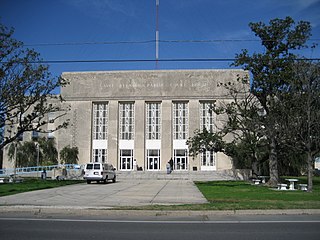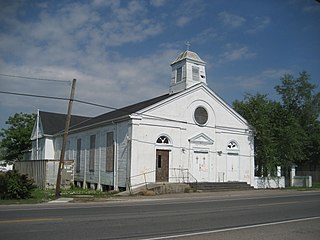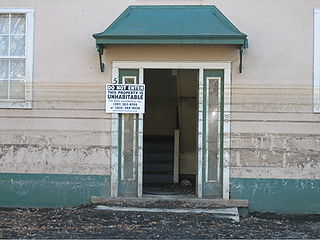
St. Tammany Parish is a parish located in the U.S. state of Louisiana named after Tamanend, the legendary Lenape Chief of Chiefs and the "Patron Saint of America." At the 2020 census, the population was 264,570, making it the fourth-most populous parish in Louisiana. The parish seat is Covington. The parish was founded in 1810.

St. Bernard Parish is a parish in the U.S. state of Louisiana. The parish seat and largest community is Chalmette. The parish was formed in 1807. St. Bernard Parish is part of the New Orleans–Metairie metropolitan statistical area; the parish is located southeast of the city of New Orleans and comprises the Chandeleur Islands and Chandeleur Sound in the east.

Chalmette is a census-designated place (CDP) in, and the parish seat of, St. Bernard Parish in southeastern Louisiana, United States. The 2010 census reported that Chalmette had 16,751 people; 2011 population was listed as 17,119; however, the pre-Katrina population was 32,069 at the 2000 census. At the 2020 U.S. census, its population rebounded to 21,562. Chalmette is part of the New Orleans–Metairie–Kenner metropolitan statistical area. Chalmette is located east of downtown New Orleans and south of Arabi, towards Lake Borgne.

Violet is a census-designated place (CDP) in St. Bernard Parish, Louisiana, United States. The population was 5,758 at the 2020 census. Violet is located on the east bank of the Mississippi River, approximately 7.5 miles (12.1 km) southeast of New Orleans and is part of the New Orleans–Metairie–Kenner metropolitan statistical area.

Saint Louis Cemetery is the name of three Catholic cemeteries in New Orleans, Louisiana. Most of the graves are above-ground vaults constructed in the 18th and 19th centuries.

Tremé is a neighborhood in New Orleans, Louisiana. "Tremé" is often rendered as Treme, and the neighborhood is sometimes called by its more formal French name, the Faubourg Tremé; it is listed in the New Orleans City Planning Districts as Tremé / Lafitte when including the Lafitte Projects.
The Mississippi River–Gulf Outlet Canal is a 76 mi (122 km) channel constructed by the United States Army Corps of Engineers at the direction of Congress in the mid-20th century that provided a shorter route between the Gulf of Mexico and New Orleans' inner harbor Industrial Canal via the Intracoastal Waterway. In 2005, the MRGO channeled Hurricane Katrina's storm surge into the heart of Greater New Orleans, contributing significantly to the subsequent multiple engineering failures experienced by the region's hurricane protection network. In the aftermath the channel was closed. A permanent storm surge barrier was constructed in the MRGO in 2009, and the channel has been closed to maritime shipping.

Clarence Raymond Joseph Nagin Jr. is an American former politician who was the 60th Mayor of New Orleans, Louisiana, from 2002 to 2010. A Democrat, Nagin became internationally known in 2005 in the aftermath of Hurricane Katrina.

Hurricane Katrina was a devastating and deadly Category 5 Atlantic hurricane that caused 1,392 fatalities and damages estimated at $186.3 billion in late August 2005, particularly in the city of New Orleans and its surrounding area. Katrina was the twelfth tropical cyclone, the fifth hurricane, and the third major hurricane of the 2005 Atlantic hurricane season. It was also the fourth-most intense Atlantic hurricane to make landfall in the contiguous United States, gauged by barometric pressure.

The reconstruction of New Orleans refers to the rebuilding process endured by the city of New Orleans after Hurricane Katrina destroyed much of the city on August 29, 2005. The storm caused levees to fail, releasing tens of billions of gallons of water. The levee failure contributed to extensive flooding in the New Orleans area and surrounding parishes. About 80% of all structures in Orleans Parish sustained water damage. Over 204,000 homes were damaged or destroyed, and more than 800,000 citizens displaced—the greatest displacement in the United States since the Dust Bowl of the 1930s. Wind damage was less severe than predicted. The damage that took place that needed to be repaired cost about $125 billion.

This article contains a historical timeline of the events of Hurricane Katrina on August 23–30, 2005 and its aftermath.

The Lower Ninth Ward is a neighborhood in the city of New Orleans, Louisiana. As the name implies, it is part of the 9th Ward of New Orleans. The Lower Ninth Ward is often thought of as the entire area within New Orleans downriver of the Industrial Canal; however, the City Planning Commission divides this area into the Lower Ninth Ward and Holy Cross neighborhoods.

Gentilly is a broad, predominantly middle-class and racially diverse section of New Orleans, Louisiana. The Gentilly neighborhood is bounded by Lake Pontchartrain to the north, France Road to the east, Bayou St. John to the west, and CSX Transportation railroad tracks to the south.

Emergency Communities was a volunteer organization which formed after Hurricane Katrina in 2005. It provided meals and other relief to residents and emergency responders, first in Mississippi, then in Louisiana. Emergency Communities ran sites in St. Bernard Parish, Plaquemines Parish, and Orleans Parish's Lower Ninth Ward, and then closed its doors on Thanksgiving of 2007. Nonprofit organization lowernine.org took the reins with regard to Emergency Communities' rebuild work, and continues to work on Eldorado Street rebuilding homes for residents of this devastated community. As of June 2009, lowernine.org has rebuilt twenty homes, in addition to working on hundreds of projects large and small across the community.

Henry Joseph Rodriguez, Jr., known as Junior Rodriguez, was an American politician from St. Bernard Parish in the Greater New Orleans section of the U.S. state of Louisiana. He was of Isleño descent and was registered as an Independent. He served as Councilmember on the St. Bernard Parish Council from 1976 to 2004 and as President of the St. Bernard Parish Council, from 2004 to 2008. St. Bernard Parish is a Louisiana Parish that is adjacent to New Orleans' Lower Ninth Ward neighborhood.

SBP is a nonprofit, disaster relief organization. After temporarily volunteering in St. Bernard Parish, Louisiana after Hurricane Katrina, Liz McCartney and Zack Rosenburg returned permanently in March 2006 and founded the project. The organization eventually expanded to include offices in New Orleans and Baton Rouge in Louisiana, Joplin, Missouri, Columbia, South Carolina, New Jersey, New York, and West Virginia. By August 2022, SBP's national impact included assistance to 5,500 families, including the rebuilding of over 1,200 homes, including 600 in New Orleans. They have collaborated extensively with Toyota and Americorps. As a result of its accomplishments, the organization and its founders have been recognized by Senator Mary Landrieu, CNN, and President Barack Obama.

Chris Rose is a New York Times Best-Selling New Orleans, Louisiana, writer and journalist. For years best known for light-hearted writing in the Times-Picayune, he gained greater attention for his chronicles of the effect of Hurricane Katrina on New Orleans since 2005.

Internally displaced persons in the United States are people from the Gulf States region in the southern United States, most notably New Orleans, Louisiana, who were forced to leave their homes because of the devastation brought on by Hurricane Katrina in 2005 and were unable to return because of a multitude of factors, and are collectively known as the Gulf Coast diaspora and by standard definition considered IDPs. At their peak, hurricane evacuee shelters housed 273,000 people and, later, FEMA trailers housed at least 114,000 households. Even a decade after Hurricane Katrina, many victims who were forced to relocate were still unable to return home.
The Community Center of St Bernard (CCSTB) is a 501(c)(3) nonprofit organization located in Arabi, Louisiana, in St Bernard Parish near New Orleans. The Community Center was founded in 2006 to serve local residents after the overwhelming devastation caused by Hurricane Katrina and Hurricane Rita. The center was closed briefly during Hurricane Gustav, but was able to reopen almost immediately after the storm. The purpose of the Community Center is to assist local residents in their return to their homes, and to help normalize life.
Leslie Rosenthal Jacobs is an education reform advocate, business executive, and philanthropist. Born in New Orleans and a graduate of Cornell University, she built her family's small, independent insurance agency into one of the largest in the South, before merging the Rosenthal Agency with Hibernia National Bank. While President of Rosenthal Agency, Jacobs worked with the business community and the legislature to create the Louisiana Workers Compensation Corporation (LWCC) and served on its inaugural board of directors. The LWCC solved a state workers compensation crisis and today Louisiana has competitive and stable workers compensation rates. She went on to become a co-founder of Strategic Comp, a workers compensation insurance company that sold to Great American in 2008.
















